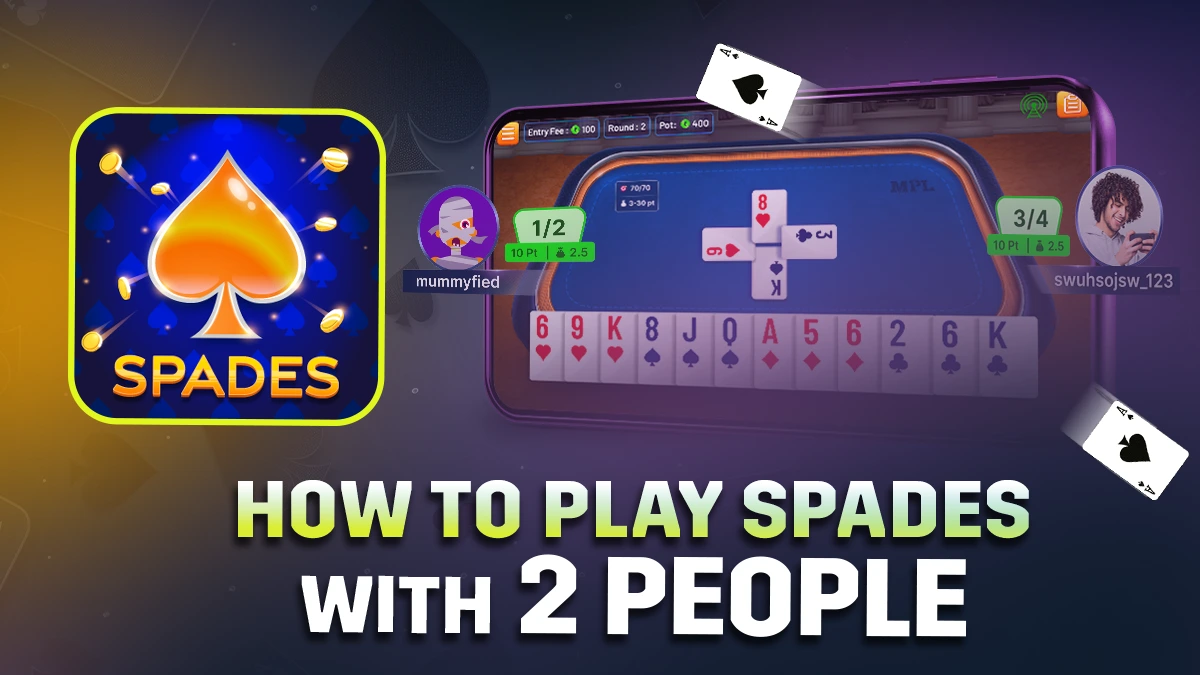Table of Contents
ToggleSpades is a strategic trick-avoidance game with psychological challenges. It is usually played with four players in partnerships, which ensures balance through partnership support. You can also play the game with two players. The question is how to play spades with 2 people. Let’s discover the rules of Spades 2-player game to make it easy for you.
What is a Two-Player Spades Game?
The two-player Spades game is simply a variation of the traditional Spades game where there are no partnerships. Hence, the responsibility of careful bidding and winning tricks lies with individual players. This increases pressure on each player’s mental capacity to accurately predict and observe the opponent’s game for strategizing.
The rules are similar to the four-player version, except no dealer in the Spades card game 2-player. Also, the 2-player game progresses fast, so you can play multiple rounds quickly.
Since there are only two players, players have more opportunities to track cards. The initial phase of the game is more collaborative, as there is no dealer. Although the game is tough and riskier, it is equally rewarding for winners due to a lack of partners to share winning rewards.
Rules to Play Spades with 2 Players
- Cards rank from Ace (high) to two (low) in every suit. Spades are trump, with the Ace of Spades being the strongest card.
- Players draw cards from the entire deck without a dealer.
- You draw a card and decide to keep or discard it. Based on that choice, you handle the next card.
- Both players end up with 13 cards. The remaining 26 cards are discarded and unused in the game.
- Each player bids on how many tricks they can win. Winning the promised bid earns 10 points per trick. Miss it, and you lose 10 points for each trick bid.
- You can bid “nil” if you think you will not win any tricks. A successful nil earns 100 points, while failure results in a 100-point penalty. Bid blind nil, and you will double both rewards and penalties (+200 or -200).
- The second player starts the first trick.
- Follow the leading suit if possible. If you can’t, play any card.
- Spades trump other suits. It can beat any non-Spade card.
- You can’t lead with Spades until someone plays them when no other suit is available (“broken”).
- Keep tricks face-down until the round ends.
- If you break the rules, e.g., not following suit or leading Spades too early, your opponent gets all your points for that round. It is known as reneging.
How to Play Spades with 2 People Step by Step
When learning how to play spades with 2 players step by step, you must grasp bidding and types of bids, trick-avoidance, sandbagging, and scoring rules. The rules are easy, but mastering them takes time.
Card Ranking
The card ranks in two-player Spades follow the below order from high to low:
- Ace (A) ♠️
- King (K) ♠️
- Queen (Q) ♠️
- Jack (J) ♠️
- Ten (10 ♠️)
- Nine (9 ♠️)
- Eight (8 ♠️)
- Seven (7 ♠️)
- Six (6 ♠️)
- Five (5 ♠️)
- Four (4 ♠️)
- Three (3 ♠️)
- Two (2 ♠️)
Learn More About Spades: A Quick Guide to the Spades Card Game
Objective
In the Spades 2-player game, the goal is to predict and win a set number of tricks each round. The scoring and rules match the 4-player version. But only 26 cards are dealt per round. The first player to reach 500 points bags the win.
Dealing
Two-player Spades game also uses the standard 52-card deck, but there is no dealing. The deck is shuffled. Instead of dealing, players take turns drawing cards. Each player draws two cards per turn. They should keep one and discard the other. If the first card is kept, the second is discarded, and vice versa. This continues until both players have 13 cards. The discarded cards are not used in the gameplay.
Bidding
In 2-player Spades, the second player leads by making a bid after looking at their cards. They predict how many tricks they’ll win, choosing a number between 0 and 13. Since there are 13 tricks available, placing a bid of at least 6 is a sensible choice. There’s only one bidding round. A player can’t skip bidding.
Bidding nil means you believe you won’t win any tricks. If you’re right, you get 100 points. But if you win at least one trick, you lose 100 points. Usually, Bidding nil requires a very weak hand. It’s a risky choice but offers a significant reward if you succeed.
For double nil or blind nil bidding, you decide before seeing your cards. Afterward, you can swap up to three cards with discarded ones. Winning no tricks earns 200 points; failing costs 200 points.
Gameplay
In a two-player Spades game, bidding is only the beginning. The actual gameplay begins after that.
The second player starts by leading the first trick with a face-up card. Unlike the four-player version, the player who picks first during hand-building does not lead the initial trick.
Players can play any card except Spades until the suit is “broken,”. Breaking Spades means the first card played in a trick must be from a different suit. The first player should follow suit if possible; if not, they can play any card. If a Spade is played when unable to follow suit, it “trumps” the trick. The highest Spade wins.
The winner of each trick leads to the next one. It continues until all 13 tricks are complete. The aim is to win the number of tricks stated in your bid.
Sandbagging
It’s wise to avoid winning too many tricks beyond your bid. It is known as Sandbagging, which can lead to penalties. Each overtrick counts as one bag. Accumulating 10 bags results in a deduction of 100 points from your score. Having 1 or 2 bags at the end of a round is preferable to underbidding. The penalty for not meeting your bid is much more severe.
Scoring Rules
Winning Tricks: 10 points per trick that matches the team’s bid. If a player’s bid is 5 and wins five tricks, the score would be 70.
Overtricks (Bags): 1 point for each trick beyond the bid. (e.g., bid 5, win 6 = 51 points)
Nil Bid: 100 points if a player wins no tricks after bidding “nil”.
Blind Nil Bid: 200 points if a player wins no tricks after bidding “nil” before seeing their hand.
Double Nil: 400 points if both teammates win no tricks after bidding “nil”.
Double Blind Nil: 800 points (and game win) if both teammates win no tricks after bidding “nil” without seeing their hands.
Penalties
Sandbagging: Accumulating 10 overtricks (bags) results in a 100-point penalty.
Underbidding: Failing to meet a bid costs 10 points per missed trick.
Failed Nil: -100 points if a player wins any trick after bidding “nil”.
Failed Blind Nil: -200 points if a player wins a trick after blind bidding “nil”.
Failed Double Nil: -400 points if one player wins a trick after both bid “nil”.
Failed Double Blind Nil: -800 points (game loss) if one player wins a trick after both blind bid “nil”.
Reneging: Failure to follow suit or lead with Spades before breaking results in all points awarded to the opposing team for that round.
Record your score on paper following the above rules. It helps as a reference for final counting.
Learn All About The Ace of Spades Card
Also Read: How Many Spades Are in a Deck of Cards
Best Strategies for 2-Player Spades

Source: Black Salmon /shutterstock
In the Spades 2 Player game, you need to adjust your strategy since half the deck isn’t used. There is no partner to cover for you also. Internalize the below strategies to march towards win:
- Bid Carefully: Without a partner to support you, your bid must be spot on to master how to play spades with two people. Overbidding leads to sandbagging penalties, while underbidding loses points.
- Track Played Cards: Pay close attention to the cards in play. With fewer players, it’s easier to predict what your opponent holds. If they’re not playing Spades long, it’s a clear sign they’re having a fortune. Watch the cards discarded during hand-building, too, for better control.
- Save Your Spades: Since Spades are your trump cards, keep them until later when they can help you win key tricks. It is especially imperative when you’re learning “how to play 2 person spades” without a partner.
- Watch for Patterns: Observe your opponent’s bidding and playing patterns. Adjust your strategy based on their tendencies and the cards they play.
- Bluffing: Occasionally, you might play a low card to lead your opponent to think you have a weak hand. It could encourage them to play aggressively, leaving them vulnerable later.
- Use High Non-Spades Cards Wisely: Lead with high cards from other suits to force your opponent to waste their Spades early.
- Be Cautious with Nil Bids: Going nil is risky in 2 Player Spades. Try it only if you have mostly low cards and few Spades. Leading the first trick makes this harder, so it’s better if you can follow.
It’s easier to avoid leading the first trick in a two-player game. Following all 13 tricks, you can play a low card instead of letting your opponent take advantage of your nil bid.
How to Play Spades with 4 people
In general, how to play the Spades game addresses the four-player version. The game is played with 4 players split into two teams to improve teamwork and strategy. The key difference lies in dealing cards, where a dealer must be chosen. The dealer is determined randomly or by drawing cards; the highest card becomes the dealer.
Cooperating with partners is central in the four-player Spades, especially when bidding. So, individual players have less of a burden on them regarding strategizing and keen gameplay. Each player must consider their partner’s play before making any decision. Unlike in the two-player version, predicting the opposite team’s hands is difficult as the cards are distributed among four players now.
How to Play Spades with 2 People Online for Money
If you’re a skilled Spades player, you can win real money competing against other players on MPL. Featuring other card games like Gin Rummy, 3 Card Flush, and Draw 4, MPL is a legitimate platform in the USA that offers real money to winners. Depending on your skill level, you can win up to $50,000 daily in MPL Spades by joining cash games.
Conclusion
Learning how to play Spades with two people tests your strategic thinking and decision-making skills. These rules and strategies improve your gameplay and prepare you for future challenges. Explore different platforms for online play. With the rise of digital games, it can sharpen your skills while presenting cash rewards.
Top 6 Trick-Taking Card Games Similar to Spades
FAQs
Is learning two-player spades difficult?
Learning two-player Spades is relatively easy if you know basic card game rules. The game is about strategy, bidding, and trick-taking. With practice, it becomes easier to grasp and enjoy.
How many cards are used in 2 player Spades?
In two-player Spades, a standard 52-card deck is used. Each player is dealt 13 cards. The remaining cards are set aside and not used during the game.
What is the best 2-player Spades app?
The best 2-player Spades app should offer a skilled-based game in which you’re matched with suitable players. You can try RNG-certified apps like MPL, which offer Spades for real money with fair play restrictions.
What is 2 player Spades with Jokers?
Traditional Spades games do not include Jokers. The game focuses only on strategy within the four suits and their ranks. However, two-player Spades can consist of two Jokers to increase strategy. Players use Jokers as wild cards in such cases.
What is reneging in 2 Player Spades?
Reneging in 2-player Spades happens when players don’t play a card of the same suit when they can. If caught, the other player gets all the points for that round.








